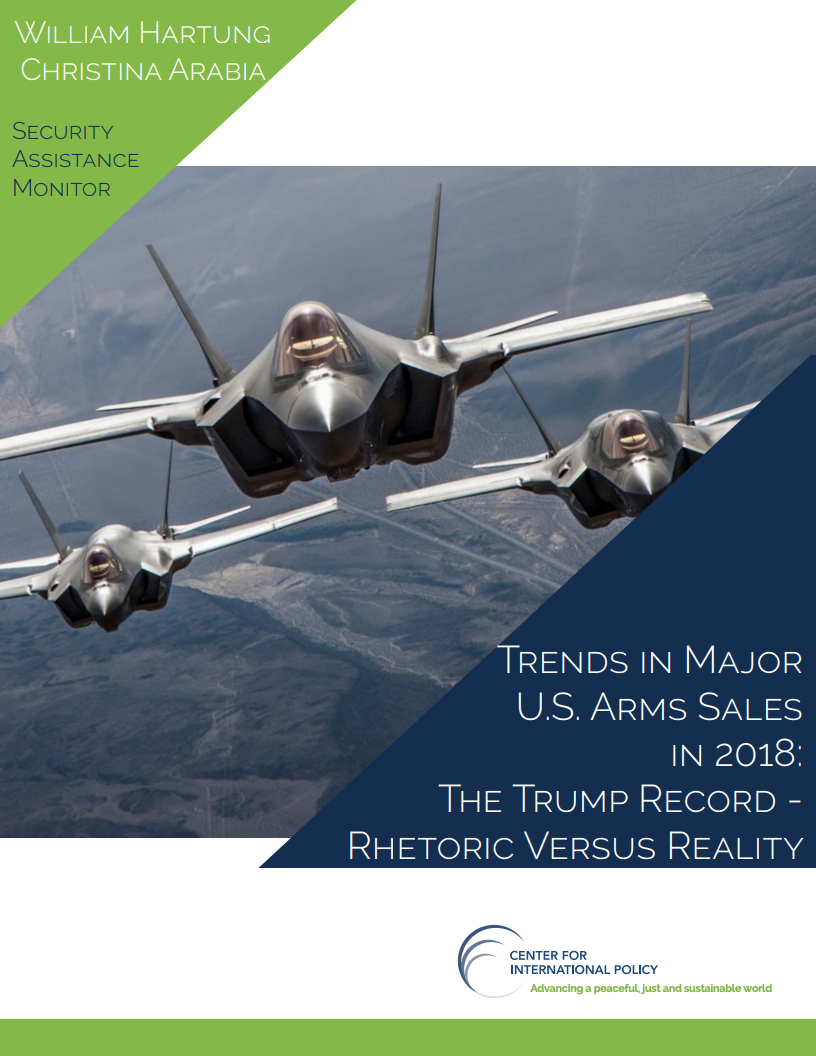Trends in Major U.S. Arms Sales in 2018: The Trump Record - Rhetoric Versus Reality
04/04/19
Trump Administration Makes $78.8 Billion in Arms Deals In 2018
Sharp Increase in Deals to Produce U.S. Weapons Overseas
A new report from the Security Assistance Monitor project of the Center for International Policy found that the Trump administration made $78.8 billion in arms deals in 2018, one-quarter of which involved the production of U.S. weapons overseas.
William D. Hartung, a coauthor of the report, said “Contrary to President Trump’s persistent claims that arms sales are a good job creator, an increasing percentage of export deals involve production of U.S. weapons overseas. Often, when the U.S. exports arms, it is also exporting jobs.”
Another concern raised by the report is a jump in deals for U.S.-produced firearms, the majority of which went to Saudi Arabia, which is engaged in a brutal war in Yemen that has created the world’s worst humanitarian crisis. Other sales of concern include a deal for the Philippines, where police and military forces have engaged in extrajudicial killings that have left thousands dead and injured. The sales increase comes at a time when the Trump administration has proposed to make it easier to sell and harder to track U.S. firearms exports.
“Given their use in major human rights abuses, firearms exports should be subjected to more scrutiny, not less,” said Christina Arabia, the director of the Security Assistance Monitor and the coauthor of the report.
Major findings of the report include:
- U.S. arms sales offers totaled $78.8 billion in 2018, a $3.4 billion drop from the figure reached during President Trump’s first year in office.
- The number and value of licenses granted to manufacture U.S. weapons and weapons components overseas increased by over 50% from 2017 to 2018, accounting for 25% of all U.S. arms offers in 2018. In all, the U.S. made 40 manufacturing license deals in 2018, worth a total of $19.8 billion.
- President Trump continued to exaggerate the number of jobs generated by U.S. arms sales, both to Saudi Arabia and globally. By the most generous estimate, total U.S. arms sales-related jobs equal two-tenths of one per cent of the U.S. labor force.
- Firearms offers increased by more than 14% in 2018, to $759 million from $662 million in 2017. The biggest recipient by far was Saudi Arabia, with over $579 million in deals that included machine guns, semi-automatic sniper rifles, and grenade launchers. Another questionable offer was a $22 million deal for handguns to the Philippines.
- The top five recipients of U.S. arms offers in 2018 were Italy ($11.4 billion), the United Kingdom ($7.3 billion), Japan ($7.2 billion) Belgium ($6.6 billion), and Saudi Arabia ($4.5 billion).
- A handful of companies were the primary beneficiaries of U.S. arms offers in 2018. The top five arms exporters, based on deals of $500 million or more, were Lockheed Martin, which was involved in deals worth $25 billion; Boeing, $7.1 billion in deals; Raytheon, $5.5 billion in deals; Northrop Grumman, had one deal worth $2.5 billion; and BAE systems, which had a $1.3 billion deal.
A number of steps can and should be taken to increase transparency and accountability in U.S. arms sales:
- End exports to regimes involved in internal repression and allies engaging in unjust wars, including Saudi Arabia, the United Arab Emirates, the Philippines, Bahrain, and Nigeria.
- Make it easier for members of Congress to be notified and act in advance of deliveries of U.S. arms, not just original offers.
- Maintain notification of commercial sales, particularly firearms, to Congress.
- Notify Congress and publish annual reports on offset deals and licensed production of U.S. arms overseas involving U.S. arms makers and their foreign clients.
- Make it possible for members of the House of Representatives to force a vote on a resolution of disapproval on specific arms sales, as is now the case in the Senate.
Click to download the report here.

